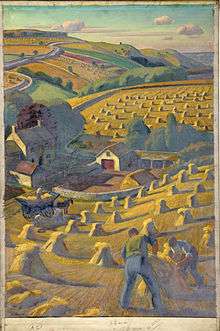Adrian Allinson
Adrian Allinson ROI (9 January 1890 – 20 February 1959) was a British painter, potter and engraver known for his landscapes of Southern Europe and North Africa, and for a series of notable posters he made for British Railways.[2][3]
Adrian Allinson | |
|---|---|
| Born | Adrian Paul Allinson 9 January 1890 London |
| Died | 20 February 1959 (aged 69) London |
| Nationality | British |
| Education | Wycliffe College, Gloucestershire[1] Slade School of Fine Art |
| Known for | Painting, pottery, sculpture, engraving |
Notable work | "The Café Royal" (1915–16), posters for London Transport (1934–40) |
| Spouse(s) | Clarke Buckland |
| Elected | Royal Society of British Artists (1933) Royal Institute of Oil Painters (1936) |

Life and career
Allinson was born in London, the eldest son of a doctor, Thomas Allinson, whose advocacy of vegetarianism and contraception had led to his being struck off the medical register.[4][5] His mother, the granddaughter of a Polish rabbi, was a portrait painter who had studied in Berlin.[6][7][8] After leaving Wycliffe College, Allinson began studying medicine, but gave this up and turned instead to art, gaining a scholarship in his second year at the Slade School of Fine Art.[2] Graduating in 1910, he travelled to Europe to study in Paris and in Munich. Following his first exhibition, at the Alpine Club Gallery, in February 1911, he became one of the founding members of the Camden Town Group,[9] and with other members later joined with the Vorticists to form The London Group.[2]
A pacifist, Allinson associated himself with the Bloomsbury Group during the First World War, producing drawings for the Daily Express newspaper and one of his most important works, a scene inside the Café Royal made in 1915–16.[10] He also designed sets for the Beecham Opera Company.[1][2][11] In 1916 he was registered as a conscientious objector.
Following the war he again travelled to Europe. He became a member of the Royal Society of British Artists in 1933 and of the Royal Institute of Oil Painters in 1936.[12][5] During the 1930s he made a series of posters for London Transport,[13] and for the Empire Marketing Board.[14] He was selected as a government war artist by the War Artists Advisory Committee during World War II. After the war, he taught at the Westminster Technical Institute. Some months before his death, he participated in the creation of a wax sculpture of Kwame Nkrumah for Madame Tussauds.[15]
Allinson died on 20 February 1959.[2]
References
- Thomas, Ronan. "Adrian Allinson 1890 – 1959". West End at War. Retrieved 3 June 2013.
- "Mr. Adrian Allinson". The Times. 21 February 1959. p. 10. Retrieved 3 June 2013.
- "Art Exhibitions". The Times. 6 November 1930. p. 12. Retrieved 4 June 2013.
Mr. Adrian Allinson ... is exhibiting paintings, drawings, wood engravings, and pottery and stoneware at the Redfern Gallery
- "ALLINSON, Adrian Paul". Who Was Who. A & C Black, an imprint of Bloomsbury Publishing plc, 1920–2008; online edn, Oxford University Press, Dec 2007. Retrieved 3 June 2013.
- Benezit Dictionary of British Graphic Artists and Illustrators, Volume 1. Oxford University Press. 2012. p. 30. ISBN 0199923051.
- "Adrian Allinson".
- Sacha Llewellyn & Paul Liss (2016). WWII War Pictures by British Artists. Liss Llewellyn Fine Art. ISBN 978-0-9930884-2-1.
- "Adrian Allinson (1890–1959)". British Council. Archived from the original on 24 June 2013. Retrieved 4 June 2013.
- "Adrian Allinson: Biography". Spartacus Educational. Spartacus Educational Publishers Ltd. Archived from the original on 3 June 2013. Retrieved 3 June 2013.
- Hillier, Bevis (9 November 1968). "Café life of 1920s recalled". The Times. p. 8. Retrieved 4 June 2013.
- Barry Smith, ed. (2000). Frederick Delius and Peter Warlock: A Friendship Revealed. Oxford University Press. p. 296. ISBN 0198167067.
- "New Members of the R.B.A." The Times. 27 April 1933. p. 14. Retrieved 4 June 2013.
- "Artist – Adrian Allinson". London Transport Museum & Transport for London. Retrieved 3 June 2013.
- Paul Jobling; David Crowley (1996). Graphic Design: Reproduction and Representation Since 1800. Manchester University Press. p. 123. ISBN 0719044677.
- "Foreign News". Jet. 15 (9): 15. 1 January 1959. ISSN 0021-5996.
External links
34 paintings by or after Adrian Allinson at the Art UK site